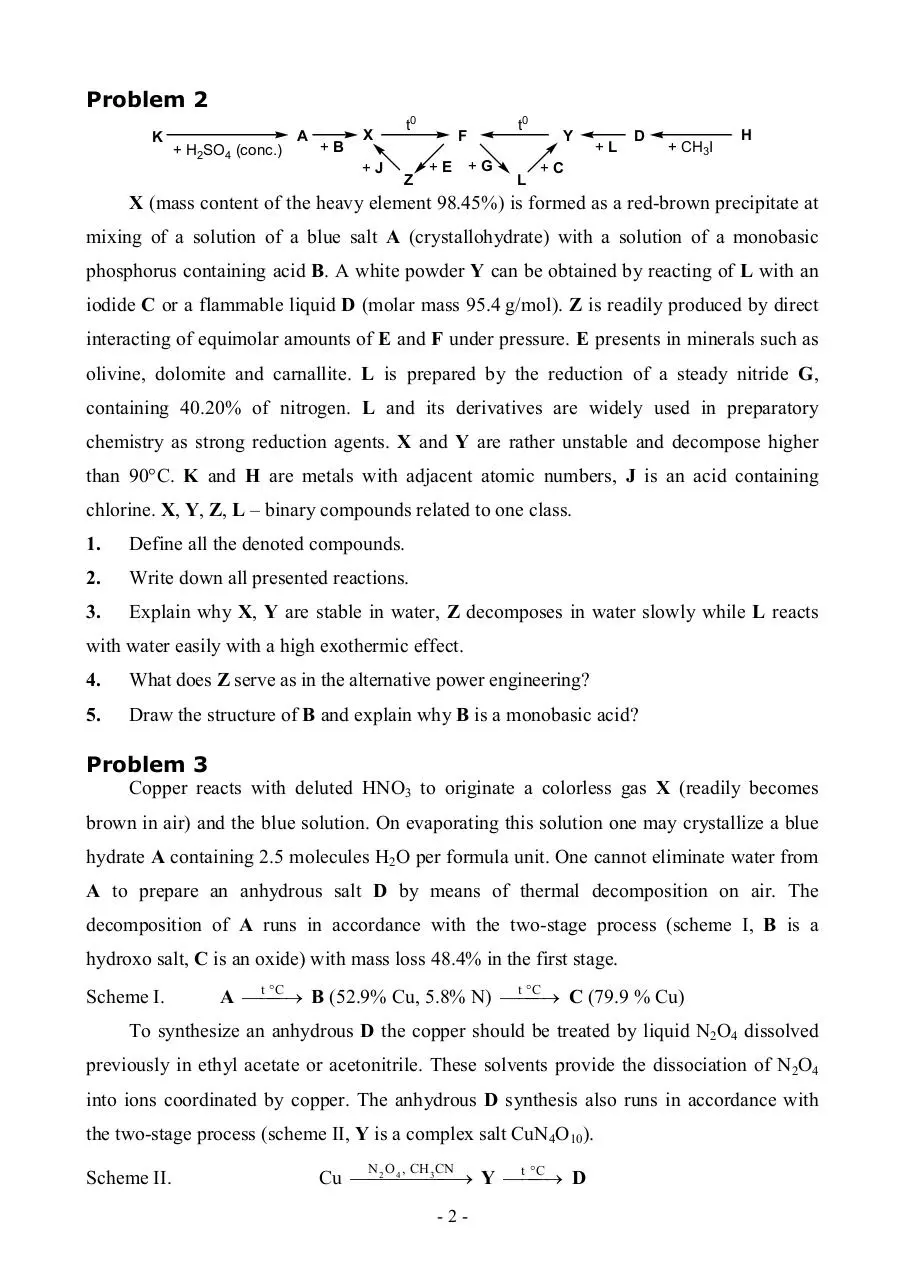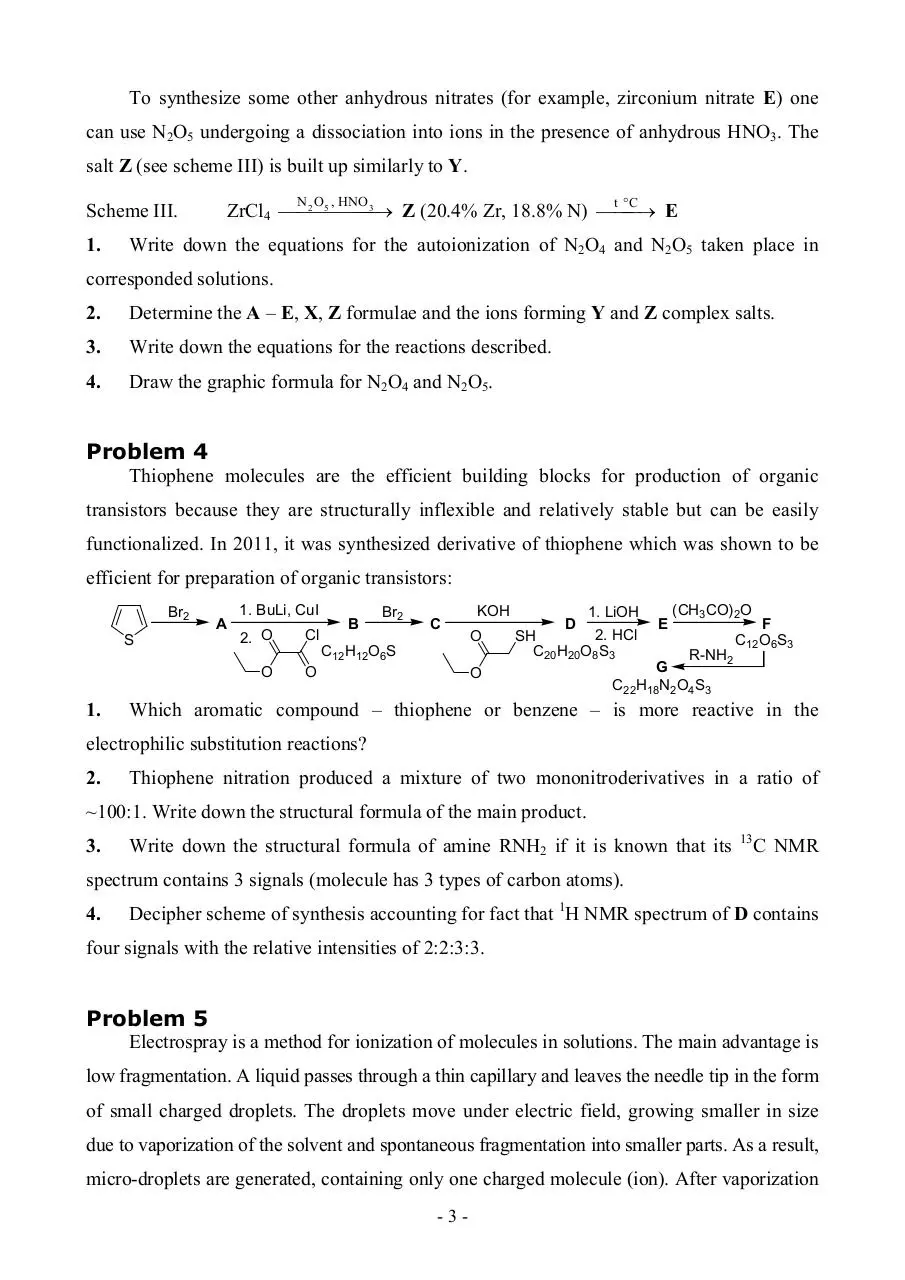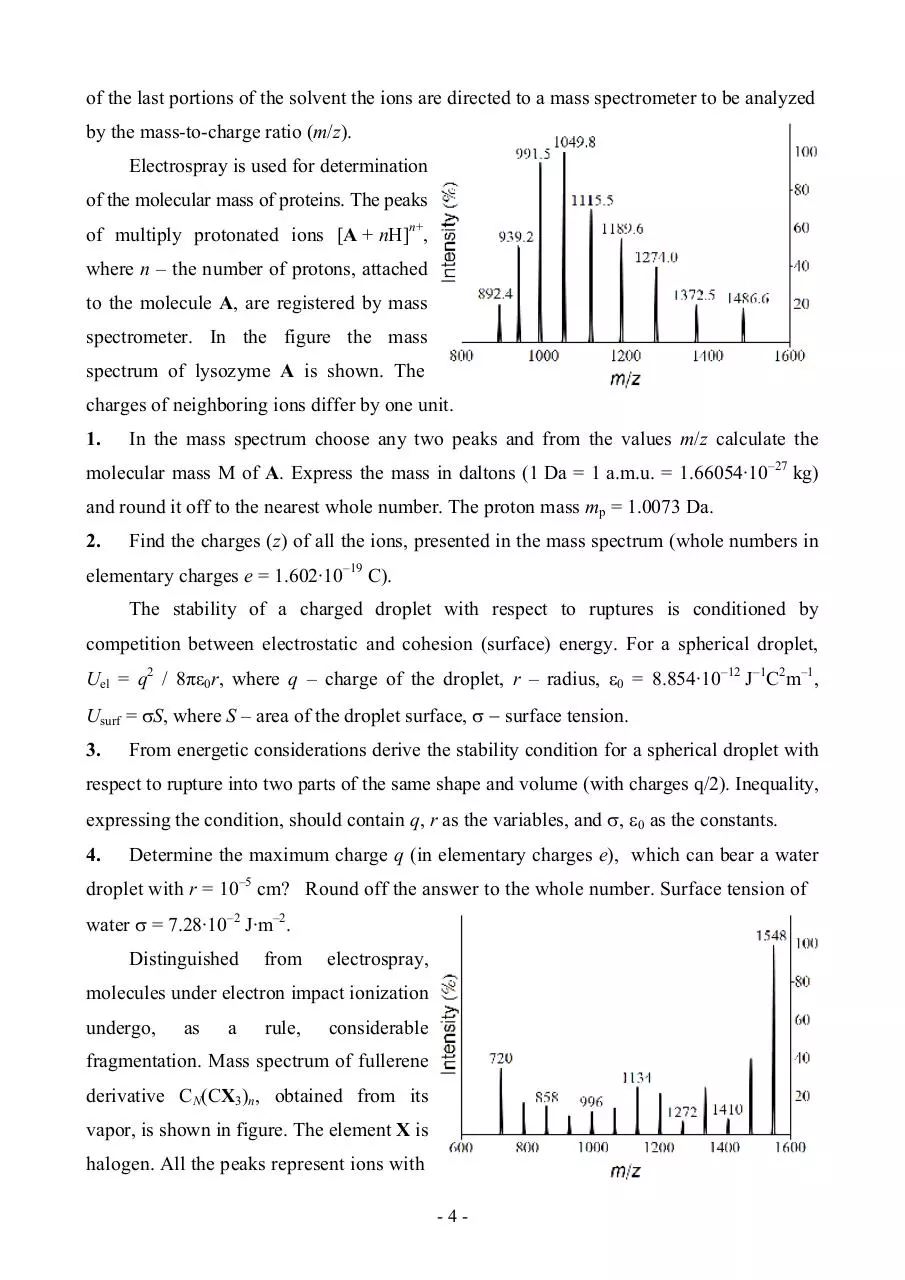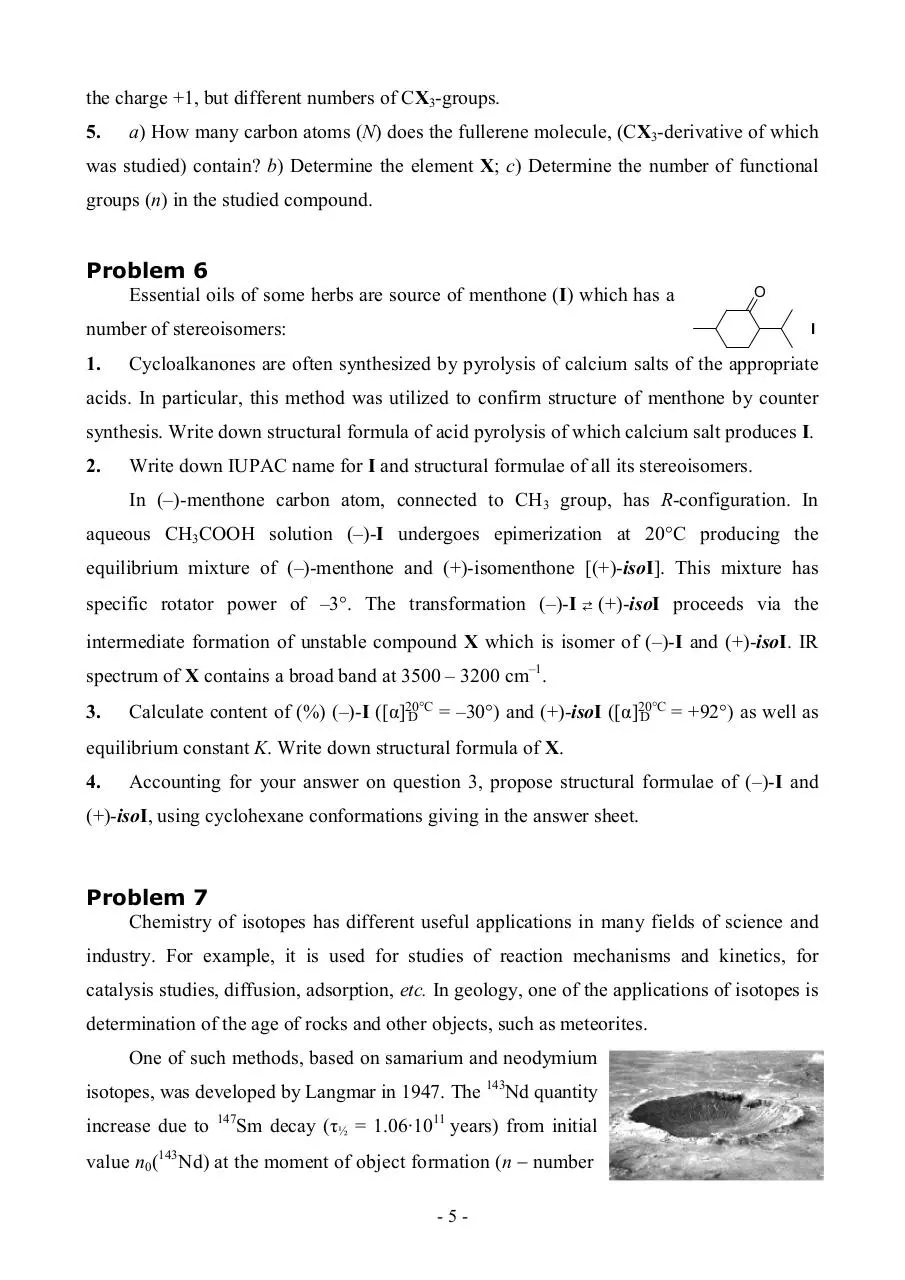2014 Tour 1 (PDF)
File information
Title: 48 IMChO - 1st tour - problems
Author: Rad
This PDF 1.4 document has been generated by pdfFactory Pro www.pdffactory.com / pdfFactory Pro 4.10 (Windows 7 Ultimate x86 Russian), and has been sent on pdf-archive.com on 07/08/2017 at 20:23, from IP address 98.228.x.x.
The current document download page has been viewed 878 times.
File size: 197.65 KB (7 pages).
Privacy: public file





File preview
Problem 1
Ascorbic acid (AA) is an important vitamin and antioxidant. Its quantity in pharmaceuticals is determined by titration with potassium iodate in 0.5 M HCl
medium in the presence of starch, during which dehydroascorbic acid
С6H6O6 (DHA) and iodide ion are formed.
1.
HO H
HO
HO
O
O
OH
Write down the equations of titration reaction and reaction producing iodine that gives
color to the indicator. Calculate the amount of AA in the sample (in mol), if 9.5 mL of
0.100 М KIO3 solution was spent for its titration.
DHA is slowly converted into xylosone C5H8O5 as a result of addition of a water
molecule and decarboxylation. Xylosone rapidly (much more rapid than during the previous
stage) is reduced by the second molecule of AA to yield xylose C5H10O5 and another
molecule of DHA. Then xylose slowly cyclizes to give furfural C5H4O2.
Having started a titration of AA (total amount: 1.00 mmol) with iodate as described in
question 1, the analyst left the lab, and when he returned, he found no ascorbic acid in
solution. At the same time, xylose and furfural were found in solution, their total amount
being 0.55 mmol.
2.
Write down the reactions of DHA and xylosone transformations during storage of the
solution using chemical formulas (no structures).
3.
What was the volume of 0.100 М iodate solution that the analyst had spent before he
left the lab?
4.
What other organic components, beside xylose and furfural, and in what quantities
were present in solution by the time the analyst returned, if the system reached equilibrium?
5.
What side reaction except for the mentioned ones could also lower the AA
concentration in solution during its storage?
If titration of AA by iodate is performed in the medium of 5 М HCl, then iodate will
be also reduced to iodide, but 7.00 mL of 0.100 М iodate solution will be spent for
0.300 mmol of AA.
6.
What will be the product of oxidation of AA under these conditions? Write down the
reaction of titration and the structure of this product if no other carbon-containing
compounds are formed in the reaction.
-1-
Problem 2
K
+ H2SO4 (conc.)
A
+B
t0
X
+J
Z
t0
F
+E
+G
L
Y
+L
D
+ CH3I
H
+C
X (mass content of the heavy element 98.45%) is formed as a red-brown precipitate at
mixing of a solution of a blue salt A (crystallohydrate) with a solution of a monobasic
phosphorus containing acid B. A white powder Y can be obtained by reacting of L with an
iodide C or a flammable liquid D (molar mass 95.4 g/mol). Z is readily produced by direct
interacting of equimolar amounts of E and F under pressure. E presents in minerals such as
olivine, dolomite and carnallite. L is prepared by the reduction of a steady nitride G,
containing 40.20% of nitrogen. L and its derivatives are widely used in preparatory
chemistry as strong reduction agents. X and Y are rather unstable and decompose higher
than 90°С. K and H are metals with adjacent atomic numbers, J is an acid containing
chlorine. X, Y, Z, L – binary compounds related to one class.
1.
Define all the denoted compounds.
2.
Write down all presented reactions.
3.
Explain why X, Y are stable in water, Z decomposes in water slowly while L reacts
with water easily with a high exothermic effect.
4.
What does Z serve as in the alternative power engineering?
5.
Draw the structure of B and explain why B is a monobasic acid?
Problem 3
Copper reacts with deluted HNO3 to originate a colorless gas X (readily becomes
brown in air) and the blue solution. On evaporating this solution one may crystallize a blue
hydrate A containing 2.5 molecules H2O per formula unit. One cannot eliminate water from
A to prepare an anhydrous salt D by means of thermal decomposition on air. The
decomposition of A runs in accordance with the two-stage process (scheme I, B is a
hydroxo salt, C is an oxide) with mass loss 48.4% in the first stage.
Scheme I.
t °C
t °C
¾® C (79.9 % Cu)
A ¾¾
¾® B (52.9% Cu, 5.8% N) ¾¾
To synthesize an anhydrous D the copper should be treated by liquid N2O4 dissolved
previously in ethyl acetate or acetonitrile. These solvents provide the dissociation of N2O4
into ions coordinated by copper. The anhydrous D synthesis also runs in accordance with
the two-stage process (scheme II, Y is a complex salt CuN4O10).
Scheme II.
t °C
4
3
Cu ¾¾2 ¾
¾¾
¾® Y ¾¾
¾® D
N O , CH CN
-2-
To synthesize some other anhydrous nitrates (for example, zirconium nitrate E) one
can use N2O5 undergoing a dissociation into ions in the presence of anhydrous HNO3. The
salt Z (see scheme III) is built up similarly to Y.
1.
t °C
N O , HNO
5
ZrCl4 ¾¾2 ¾
¾¾
¾3 ® Z (20.4% Zr, 18.8% N) ¾¾
¾® E
Scheme III.
Write down the equations for the autoionization of N2O4 and N2O5 taken place in
corresponded solutions.
2.
Determine the А – E, X, Z formulae and the ions forming Y and Z complex salts.
3.
Write down the equations for the reactions described.
4.
Draw the graphic formula for N2O4 and N2O5.
Problem 4
Thiophene molecules are the efficient building blocks for production of organic
transistors because they are structurally inflexible and relatively stable but can be easily
functionalized. In 2011, it was synthesized derivative of thiophene which was shown to be
efficient for preparation of organic transistors:
Br2
S
1.
A
1. BuLi, CuI
2. O
Cl
O
O
B
Br2
C
C12H12O6S
KOH
O
D
1. LiOH
2. HCl
SH
C20H20O8S3
O
E
(CH3CO)2O
R-NH2
G
C22H18N2O4S3
F
C12O6S3
Which aromatic compound – thiophene or benzene – is more reactive in the
electrophilic substitution reactions?
2.
Thiophene nitration produced a mixture of two mononitroderivatives in a ratio of
~100:1. Write down the structural formula of the main product.
3.
Write down the structural formula of amine RNH2 if it is known that its
13
С NMR
spectrum contains 3 signals (molecule has 3 types of carbon atoms).
4.
Decipher scheme of synthesis accounting for fact that 1Н NMR spectrum of D contains
four signals with the relative intensities of 2:2:3:3.
Problem 5
Electrospray is a method for ionization of molecules in solutions. The main advantage is
low fragmentation. A liquid passes through a thin capillary and leaves the needle tip in the form
of small charged droplets. The droplets move under electric field, growing smaller in size
due to vaporization of the solvent and spontaneous fragmentation into smaller parts. As a result,
micro-droplets are generated, containing only one charged molecule (ion). After vaporization
-3-
of the last portions of the solvent the ions are directed to a mass spectrometer to be analyzed
by the mass-to-charge ratio (m/z).
Electrospray is used for determination
of the molecular mass of proteins. The peaks
of multiply protonated ions [A + nH]n+,
where n – the number of protons, attached
to the molecule A, are registered by mass
spectrometer. In the figure the mass
spectrum of lysozyme A is shown. The
charges of neighboring ions differ by one unit.
1.
In the mass spectrum choose any two peaks and from the values m/z calculate the
molecular mass M of A. Express the mass in daltons (1 Da = 1 a.m.u. = 1.66054∙10–27 kg)
and round it off to the nearest whole number. The proton mass mp = 1.0073 Da.
2.
Find the charges (z) of all the ions, presented in the mass spectrum (whole numbers in
elementary charges e = 1.602∙10–19 C).
The stability of a charged droplet with respect to ruptures is conditioned by
competition between electrostatic and cohesion (surface) energy. For a spherical droplet,
Uel = q2 / 8πε0r, where q – charge of the droplet, r – radius, e0 = 8.854∙10–12 J–1C2m–1,
Usurf = sS, where S – area of the droplet surface, s - surface tension.
3.
From energetic considerations derive the stability condition for a spherical droplet with
respect to rupture into two parts of the same shape and volume (with charges q/2). Inequality,
expressing the condition, should contain q, r as the variables, and s, e0 as the constants.
4.
Determine the maximum charge q (in elementary charges e), which can bear a water
droplet with r = 10–5 cm? Round off the answer to the whole number. Surface tension of
water s = 7.28∙10–2 J∙m–2.
Distinguished
from
electrospray,
molecules under electron impact ionization
undergo,
as
a
rule,
considerable
fragmentation. Mass spectrum of fullerene
derivative CN(CX3)n, obtained from its
vapor, is shown in figure. The element X is
halogen. All the peaks represent ions with
-4-
the charge +1, but different numbers of CX3-groups.
5.
a) How many carbon atoms (N) does the fullerene molecule, (CX3-derivative of which
was studied) contain? b) Determine the element X; c) Determine the number of functional
groups (n) in the studied compound.
Problem 6
Essential oils of some herbs are source of menthone (I) which has a
number of stereoisomers:
1.
O
I
Cycloalkanones are often synthesized by pyrolysis of calcium salts of the appropriate
acids. In particular, this method was utilized to confirm structure of menthone by counter
synthesis. Write down structural formula of acid pyrolysis of which calcium salt produces I.
2.
Write down IUPAC name for I and structural formulae of all its stereoisomers.
In (–)-menthone carbon atom, connected to СН3 group, has R-configuration. In
aqueous СН3СООН solution (–)-I undergoes epimerization at 20°С producing the
equilibrium mixture of (–)-menthone and (+)-isomenthone [(+)-isoI]. This mixture has
specific rotator power of –3°. The transformation (–)-I ⇄ (+)-isoI proceeds via the
intermediate formation of unstable compound X which is isomer of (–)-I and (+)-isoI. IR
spectrum of X contains a broad band at 3500 – 3200 cm–1.
3.
= +92°) as well as
= –30°) and (+)-isoI ([α]20°C
Calculate content of (%) (–)-I ([α]20°C
D
D
equilibrium constant K. Write down structural formula of Х.
4.
Accounting for your answer on question 3, propose structural formulae of (–)-I and
(+)-isoI, using cyclohexane conformations giving in the answer sheet.
Problem 7
Chemistry of isotopes has different useful applications in many fields of science and
industry. For example, it is used for studies of reaction mechanisms and kinetics, for
catalysis studies, diffusion, adsorption, etc. In geology, one of the applications of isotopes is
determination of the age of rocks and other objects, such as meteorites.
One of such methods, based on samarium and neodymium
isotopes, was developed by Langmar in 1947. The 143Nd quantity
increase due to
147
Sm decay (τ½ = 1.06∙1011 years) from initial
value n0(143Nd) at the moment of object formation (n - number
-5-
of moles). The quantity of
144
Nd does not change in time, permitting determination of the
sample age, measuring the ratios 143Nd/144Nd and 147Sm/144Nd by mass spectrometry.
In 1940, in Australia, there was found a meteorite, named Moama. It is believed that
the age of this meteorite is comparable to the age of Solar system. In 1978 two minerals
were extracted from Moama - plagioclase and pyroxene, which were analyzed:
Mineral
Plagioclase
Pyroxene
n(143Nd) / n(144Nd)
0.510
0.515
n(147Sm) / n(144Nd)
0.111
0.280
1.
a) Write down the decay reaction for 147Sm;
2.
Determine the initial ratio n0(143Nd) / n0(144Nd) at the moment of meteorite formation
b) Determine the decay constant.
using table data. Remember that n0(143Nd) / n(144Nd) is the same for both minerals.
3.
Calculate the age of Moama.
4.
Is it possible, using Langmar’s method, to determine the age of rocks, which were
formed in 3 - 5 millennium B.C.? Confirm the answer by a numerical example.
Problem 8
The President of the Palestinian National Authority, Nobel Peace Prize laureate
Y. Arafat died suddenly under strange circumstances in November 2004. In 2012 the
Y. Arafat’s body was exhumed as insisted by his widow, and the tissue samples were
subjected to analysis. The results demonstrated the probability of Y. Arafat’s death because
of the fatal poisoning with the substance containing an isotope of X.
The numbers of α-particles emitted in a unit of time by 1.00 mg sample of
(T½ = 138.4 days) and 4.55 g sample of 226Ra (T½ = 1601 year) are identical.
1.
Write down the equation of radioactive decay of 226Ra isotope.
2.
Calculate the molar mass of X.
3.
When the exhumation of Y. Arafat’s body (70 kg) would have become meaningless
due to decreasing of the total α-radioactivity of the organism tissues up to 0.3 Bq/kg, if:
a)
the minimal lethal dose of X is 1 μg;
b)
in norm, the α-activity (Aα) of human body (70 kg) is 0.2 Bq/kg, this value
staying unchanged for many years;
с)
a non-radioactive isotope is formed from X in the process of its α-decay.
The ratio of the number of neutrons to protons (N/Z) in X equals 1.50.
4.
Determine X.
-6-
More than 90% of X is produced in Russia. The
209
Bi isotope is used as the target in
the one-step procedure for obtaining X.
5.
Write down the theoretically possible equations of nuclear reactions if the total mass
of all the rest (but X and 209Bi) particles in the reaction does not exceed 1 a.m.u.
A sample of X of 1 cm3 (ρX = 9.2 g/cm3) evolves significant energy per time unit
(1210 W), which is comparable to that of an electric iron. This is behind the extreme
toxicity of X for living things.
6.
Calculate the initial kinetic energy (in MeV) of the α-particle formed in X decay
supposed the kinetic energy completely transforms into the heat one (1 eV = 1.6∙10–19 J).
-7-
Download 2014 Tour 1
2014 Tour 1.pdf (PDF, 197.65 KB)
Download PDF
Share this file on social networks
Link to this page
Permanent link
Use the permanent link to the download page to share your document on Facebook, Twitter, LinkedIn, or directly with a contact by e-Mail, Messenger, Whatsapp, Line..
Short link
Use the short link to share your document on Twitter or by text message (SMS)
HTML Code
Copy the following HTML code to share your document on a Website or Blog
QR Code to this page

This file has been shared publicly by a user of PDF Archive.
Document ID: 0000635278.